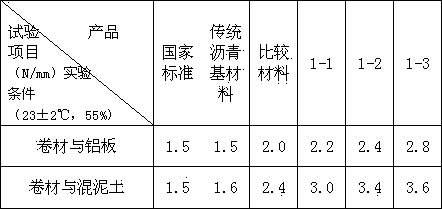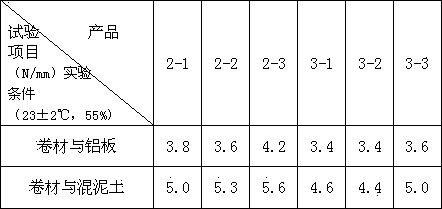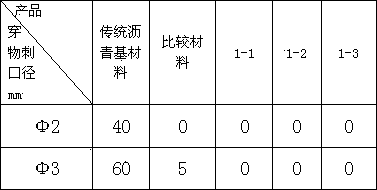Preparation method of nanoscale filler modified non-asphaltic waterproof material
A nano-scale filler and waterproof material technology, applied in the field of waterproof materials, can solve problems such as cracking and poor self-healing, and achieve the effect of improving densification viscoelastic performance, good peeling performance, and improving bonding effect
- Summary
- Abstract
- Description
- Claims
- Application Information
AI Technical Summary
Problems solved by technology
Method used
Image
Examples
Embodiment 1-1
[0041] Using the first group of raw materials, follow the steps below to make 1-1 product.
[0042] a. Pour the rubber oil into the batching reaction kettle and heat up to 195°C to remove the moisture inside;
[0043] b. Add desulfurized rubber powder in step a, continue to heat up to 205°C, stir for 3 hours until the desulfurized rubber powder is completely melted, and make a liquid rubber blend;
[0044] c. Grinding the liquid rubber blend in the above step b, so that the fineness of the particles inside reaches below 250 μm, and transfer it to the blending tank;
[0045] d. Cool down the liquid in the blending tank in the above step c to 195°C, add hot-melt adhesive grade elastomer, styrene-butadiene-styrene block copolymer and viscosifying elastomer, control the temperature at 190°C and stir until melted Adhesive grade elastomers, styrene-butadiene-styrene block copolymers and tackifying elastomers are completely melted;
[0046] e. Add high-temperature resin and tackify...
Embodiment 1-2
[0048] Using the first group of raw materials, follow the steps below to make 1-2 products.
[0049] a. Pour the rubber oil into the batching reaction kettle and heat up to 200°C to remove the moisture inside;
[0050] b. Add desulfurized rubber powder in step a, continue to heat up to 215°C, stir for 4 hours until the desulfurized rubber powder is completely melted, and make a liquid rubber blend;
[0051] c. Grinding the liquid rubber blend in the above step b, so that the fineness of the particles inside reaches below 250 μm, and transfer it to the blending tank;
[0052] d. Cool down the liquid in the blending tank in the above step c to 200°C, add hot-melt adhesive grade elastomer, styrene-butadiene-styrene block copolymer and viscosity-increasing elastomer, control the temperature at 195°C and stir until melted Adhesive grade elastomers, styrene-butadiene-styrene block copolymers and tackifying elastomers are completely melted;
[0053]e. Add high-temperature resin and...
Embodiment 1-3
[0055] Using the first group of raw materials, follow the steps below to make products 1-3.
[0056] a. Pour the rubber oil into the batching reaction kettle and heat up to 187°C to remove the moisture inside;
[0057] b. Add desulfurized rubber powder in step a, continue to heat up to 210°C, and stir for 3.5 hours until the desulfurized rubber powder is completely melted to form a liquid rubber blend;
[0058] c. Grinding the liquid rubber blend in the above step b, so that the fineness of the particles inside reaches below 250 μm, and transfer it to the blending tank;
[0059] d. Cool down the liquid in the blending tank in the above step c to 198°C, add hot melt adhesive grade elastomer, styrene-butadiene-styrene block copolymer and viscosifying elastomer, control the temperature at 193°C and stir until melted Adhesive grade elastomers, styrene-butadiene-styrene block copolymers and tackifying elastomers are completely melted;
[0060] e. Add high-temperature resin and ta...
PUM
| Property | Measurement | Unit |
|---|---|---|
| Fineness | aaaaa | aaaaa |
Abstract
Description
Claims
Application Information
 Login to View More
Login to View More - R&D
- Intellectual Property
- Life Sciences
- Materials
- Tech Scout
- Unparalleled Data Quality
- Higher Quality Content
- 60% Fewer Hallucinations
Browse by: Latest US Patents, China's latest patents, Technical Efficacy Thesaurus, Application Domain, Technology Topic, Popular Technical Reports.
© 2025 PatSnap. All rights reserved.Legal|Privacy policy|Modern Slavery Act Transparency Statement|Sitemap|About US| Contact US: help@patsnap.com



